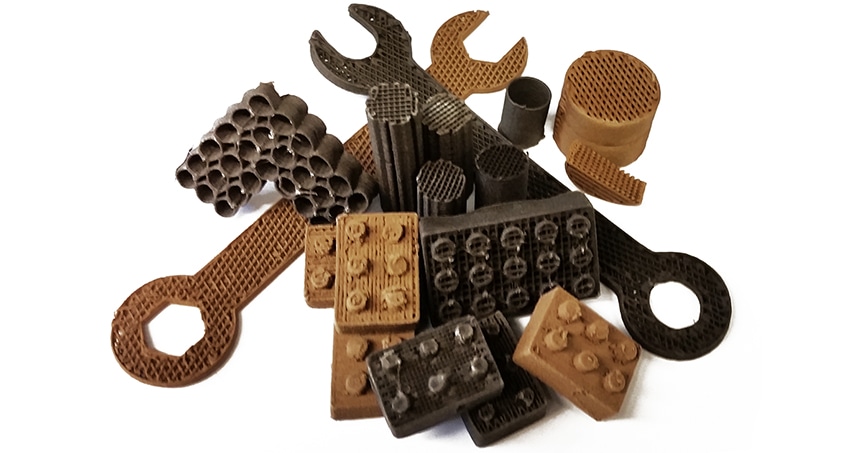Apr 13 2017
 Tools and building blocks made by 3D printing with lunar and Martian dust. Credit: Northwestern University
Tools and building blocks made by 3D printing with lunar and Martian dust. Credit: Northwestern University
When human beings start to colonize Mars and the moon, they would have to make everything from tiny tools to large-sized buildings, using the limited number of surrounding resources.
Now, Ramille Shah and her Tissue Engineering and Additive Manufacturing (TEAM) Laboratory at Northwestern Engineering have shown the potential to 3D-print structures with lunar and Martian dust simulants. In this study, the researchers used an extension of their “3D-painting process,” a term coined by Shah and her team for their new 3D inks and printing method, which they earlier used to print 3D graphene and carbon nanotubes, hyperelastic “bone”, and alloys and metals. 3D-printing presents an easy, sustainable, and highly scalable manufacturing method for space travelers.
For places like other planets and moons, where resources are limited, people would need to use what is available on that planet in order to live. Our 3D paints really open up the ability to print different functional or structural objects to make habitats beyond Earth.
Ramille Shah, Assistant Professor of Materials Science and Engineering, McCormick School of Engineering
The study, which was partly supported by a gift from Google and conducted at Northwestern’s Simpson Querrey Institute, has been described in Nature Scientific Reports. The paper’s first author was Adam Jakus, who is also a Hartwell postdoctoral fellow in Shah’s TEAM lab. The work was co-authored by two former Northwestern Engineering undergraduates, Katie Koube, who now works as an engineer for SpaceX, and Nicholas Geisendorfer, who is currently a graduate student in Shah’s lab.
Shah’s work employs NASA-approved simulants of lunar and Martian dust, which have similar particle shapes, sizes, and compositions to the dusts present on Martian and lunar surfaces. By using the respective dusts, biopolymer, and a range of simple solvents, the team was able to produce Martian and lunar 3D paints. These paints were then 3D printed using a simple extrusion process. The structures thus obtained were more than 90% dust by weight.
Although the resulting 3D-painted material was made of rigid micro-rocks, it was still elastic, flexible, and strong, just like rubber. The study is the first, unique example of soft or rubber-like materials resulting from Martian and lunar simulant materials. The 3D-painted material can be rolled, cut, folded, and if required can be shaped after it is 3D painted.
We even 3D-printed interlocking bricks, similar to Legos, that can be used as building blocks.
Ramille Shah, Assistant Professor of Materials Science and Engineering, McCormick School of Engineering
Shah and David Dunand, the James N. and Margie M. Krebs Professor of Materials Science and Engineering, are now working together to improve ways to fire these 3D-painted materials in a furnace, which is an alternative process that can change the soft and rubbery objects into tough, ceramic-like structures. In the context of the wider 3D-painting technology, the study also presents a possibility of using a 3D printer on another planet to develop structures from many different types of materials.
Despite the fact that colonizing other planets may take some time, Shah believes that it is never too early to start planning.